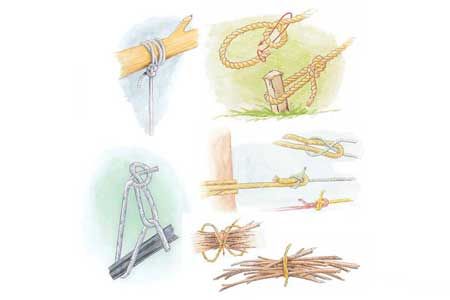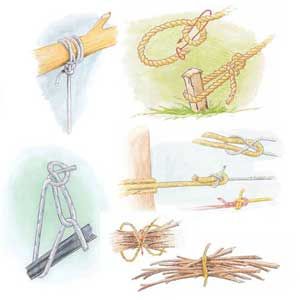
Whether you’re securing a hammock, bundling branches, or tying down cargo, knowing the right knot for the job is invaluable. In this guide, we’ll explore five essential knots that every homeowner should have in their repertoire. These knots are simple to learn and can help you tackle various household tasks.
The Bowline: Creating a Loop That Won’t Slip
The bowline is often called the “king of knots” due to its versatility and reliability. This knot creates a fixed loop that won’t slip or tighten under load, making it ideal for a wide range of applications around the home.
Step-by-Step Guide To Tying a Bowline
- Make a small loop in the standing part of the rope.
- Pass the working end up through the loop.
- Bring the working end around behind the standing part.
- Pass the working end back down through the small loop.
- Hold the standing part and the loop, then pull the working end to tighten.
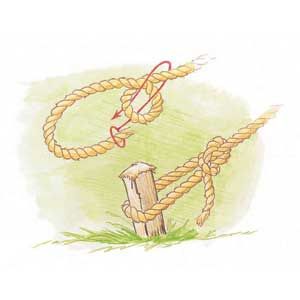
Practical Applications for the Bowline Knot
The bowline is useful in the following scenarios:
- Attaching a rope to a fixed ring or hook
- Creating a secure loop for clotheslines
- Hanging plants or bird feeders from tree branches
- Laying out garden beds or landscaping projects with string
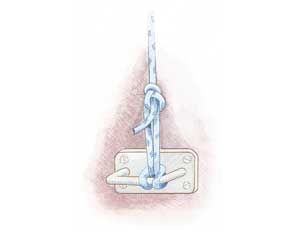
The Sheet Bend: Joining Two Ropes
The sheet bend is your go-to knot when you need to join two ropes, especially if they’re of different thicknesses. It’s strong, easy to tie and untie, and handy for extending ropes.
How To Tie a Sheet Bend
- Form a bight (U-shape) at the end of the thicker rope.
- Pass the end of the thinner rope up through the bight.
- Wrap the thinner rope around behind both parts of the thicker rope.
- Tuck the working end of the thinner rope under its standing part.
- Pull both standing ends to tighten the knot.
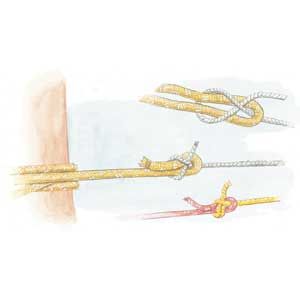
When To Use a Sheet Bend in Home Projects
The sheet bend is particularly useful in these situations:
- Creating a longer rope for bundling or tying down large items
- Extending a clothesline or garden twine
- Joining ropes for a makeshift pulley system
- Repairing a broken rope temporarily
Two Half Hitches: The Go-To Knot for Tying Off
Two half hitches is a versatile knot that’s perfect for securing a rope to a fixed object. This knot is simple and adjusts easily under tension.
Mastering the Two Half Hitches Technique
- Pass the rope’s working end around the object you’re tying to.
- Bring the working end over and under the standing part, creating a half hitch.
- Repeat step 2, creating a second half hitch below the first.
- Pull both the working end and the standing part to tighten the knot.
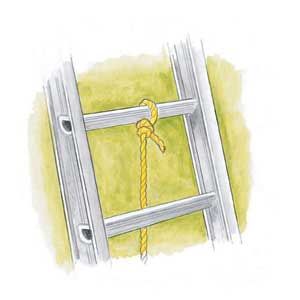
Variations and Uses Around the House
Two half hitches are incredibly versatile for homeowners:
- Fastening a rope to a tree branch for a swing
- Mooring a small boat or kayak
- Securing tarps or shade cloths in the garden
- Tying off guy lines for temporary structures
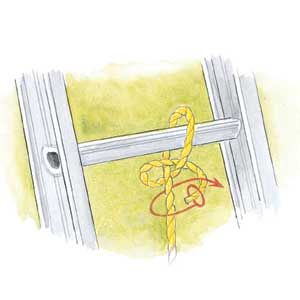
The Miller’s Knot: Perfect for Bundling and Securing
Also known as the constrictor knot, the Miller’s knot is ideal for bundling and securing objects tightly. This knot grips itself and doesn’t work loose.
Tying the Miller’s Knot: A Quick Tutorial
- Wrap the rope twice around the object you’re bundling.
- Pass the working end under the last turn.
- Bring the working end over the standing part and back under itself.
- Pull both ends to tighten the knot.
Household Uses for the Miller’s Knot
The Miller’s knot is particularly useful for:
- Bundling cords and cables for storage
- Bundling garden waste or branches for disposal
- Securing the necks of bags or sacks
- Tying off the ends of rolled carpets or rugs
The Trucker’s Hitch: Securing Heavy Loads
The trucker’s hitch is a compound knot system that provides a mechanical advantage when tightening a rope. It’s excellent for securing loads on vehicles or tightening lines for various home projects.
Step-by-Step Guide To the Trucker’s Hitch
- Tie off one end of the rope to a fixed point.
- About midway along the rope, form a loop by creating a bight and passing a section of the rope through it.
- Pass the working end around or through your anchor point.
- Thread the working end through the loop created in step 2.
- Pull down on the working end to tighten.
- Secure the working end with two half hitches around the standing part.
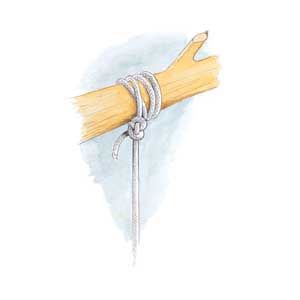
When and Where To Use the Trucker’s Hitch at Home
The trucker’s hitch is great for:
- Creating a taut clothesline
- Securing loads on car roof racks or in truck beds
- Strapping down tarps over outdoor equipment or firewood
- Tightening tent guy lines
Choosing the Right Rope for Your Knots
Selecting the appropriate rope is crucial for ensuring your knots perform as intended. We recommend considering the following factors when tying knots for home projects.
Natural vs. Synthetic Fibers
Natural fiber ropes, such as cotton or hemp, are biodegradable and have a softer feel. They’re great for indoor use and decorative purposes.
However, synthetic ropes like nylon or polyester offer superior strength and weather resistance, making them ideal for outdoor applications.
Rope Thickness and Strength Considerations
The thickness of the rope affects its strength and ease of tying. A 3/8-inch to 1/2-inch diameter rope is a versatile choice for general household use.
Knot Tying Tips and Tricks for Beginners
Learning to tie knots effectively takes practice, but these tips can help you improve quickly.
Common Mistakes To Avoid
- Avoid using a knot for any purposes it isn’t designed for.
- Don’t forget to dress the knot (arrange all parts neatly) before tightening.
- Don’t rush the process; take your time to ensure each step is correct.
- Never use a damaged or weakened rope for critical tasks.
Practice Techniques To Improve Your Skills
- Start with larger, stiffer ropes to make the knot structure more visible.
- Consider marking steps on the rope with tape to help visualize the knot formation.
- Use measuring tools to ensure consistent rope lengths when practicing.
- Practice regularly with different types of rope to build muscle memory.
Remember to use a level when setting up structures or fixtures that require knots to ensure proper alignment.
